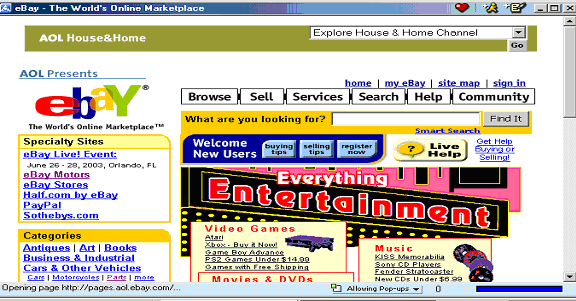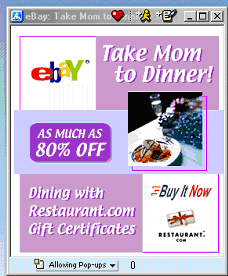George Mason University
INFS-640 (E-commerce)
Spring-2003
An Analysis of eBay
6 Marketing
From the general marketing rules, four “ P’s" which are product,
place, price, and promotion, is used as a tool to succeed in the business. In
the E-marketing, not only 4P’s used but also the important things are
the use of technology to increase efficiency of marketing increasing company
profitability and adding customer value.
6.1 eBay Marketing Strategy
The current eBay marketing strategy is base on three elements6
- Promoting their brand
- Attracting new buyers and sellers to the eBay service
- Increasing the activity of existing users
6.1.1 Promoting the brand
The “brand” makes the products or services truly unique and differentiable
in the minds of customers. Laudon and Traver’ s E-commerce defines a brand
as “ a set of expectations that a customer has consuming, or thinking
about consuming, a product or service from a specific company” 7
A powerful and more recognized brand name normally results in larger unit sale
and allows the seller to charge a premium over “unknown-brand” competitors.
Customer sometimes confronted with the perplexing choices, or many choices,
they often fall to names they know. Shelf space always first belongs to the
powerful brand names. This made less available shelf space to lesser brands.
Moreover, powerful brands can also open adjacent markets when they want to create
brand extensions.
The emphasis on brand building first started when Meg Whitman arrived in early
1998. She tried to build brand recognition at eBay. eBay's early growth relied
strictly on word of mouth. But as a professional at consumer product marketing,
she made branding one of her first initiatives. In a series of meetings with
the senior management team, she broke the problem into two parts. The first
one was clarifying what eBay stood for and it was a personal trading community
where users could buy and sell almost anything in their judgment. This definition
set eBay apart from most competitors. The second part came from Marketing 101,market
segmentation. The user community was analyzed in terms of user segments. The
heaviest sit users were serious collectors and small dealers. These users accounted
for 80 percent of total company revenues even though they represented only 20
percent as registered users. Based on this knowledge, the company decided to
emphasize its marketing and brand-building resource on them. It also exhibited
at collector trade show (over 90 in 1998 alone). Moreover, began the development
of beneficial programs for heavy users, for instant the PowerSeller program.
The company also started to strengthen its brand within the current eBay community
through marketing program on the eBay Wed site, a commercial magazine, and through
the distribution of eBay-branded merchandise.4
During Q3-4 2002, Internet marketing investments and TV advertising have grown
strong new users and increased activation rates as shown in figure 6.1. There
is a lot improvement from year 2001. 8

Figure 6.1: Impact of TV ads
SOURCE: eBay company update, February 2003
AOL and Disney are two of the largest media that eBay uses to promote the brand
The AOL Connection
In August 1998, eBay’s biggest and the most costly effort of getting name
recognition is entering into a three-year marketing deal with America Online
(AOL). Under this agreement, eBay would become AOL’ s main provider of
C2C trading services in its classified and interest area. As shown in figure
6.2 and 6.3, the eBay page in the AOL frame and the pop up window of eBay advertising
in AOL site. User can get in to this page by easily entering keyword “eBay”
in the AOL homepage. In addition, the AOL homepage would have an eBay link as
a portal for some 64 million subscribers. The price for this relationship was
$12 million. And in March 1999, this agreement was extended by another year,
and it scope was expanded to include the presence of eBay on AOL’s other
properties (Digital Cities, ICQ, CompuServe, and Netscape). eBay had to pay
the total price for this amended agreement at $75 million. At a time when most
dot-coms are suffering, the auctioneer reported $24.6 million in cash earnings
for the second quarter of 2001, more than triple the level reported a year ago,
a successful story.

Figure 6.2: the eBay page in the AOL frame

Figure 6.3: the eBay pop up window in AOL site
eBay and Disney
On February 8,2000, eBay official announced a four-year agreement with GO.com,
a network of the Walt Disney Company’s Web site, which included ABC.com,
ESPN.com, and Disney.com. Under this relationship, eBay and Disney would work
together to develop a cobranded site identified as eBay.go.com (as shown in
figure 6.4) promoted by the GO.com network. This network is an Internet portal
with millions of users and comarketed with Disney throughout the latter’s
offline channel (ABC television and radio networks, ESPN’s cable network,
Disney channel, and the Disney catalog and theme parks). The relationship with
Disney is actually not only to served the brand recognition purpose but to attract
new users as well.

Figure 6.4: eBay.go.com
6.1.2 Attracting new users
The number of registered eBay users much increased from 41,000 to million during
1996-1999, the growth rate of 535 percent annually. Even eBay has such a large
amount of users, one of its strategies is still attracting new users. The following
are three sources that eBay focuses on:
The North American market
At mid-year 2001, around 170 million people (almost 60% of the total population)
in United States had access to the Internet. This number is expected to grow
to around 215 million users by 2005 (Laudon and Traver/Addison Wesley, 2001;E-commerce).
At the same time, with 38 million registered users in 2001, 78 percent of current
Internet users were unregistered. The company hoped to gain a greater share
of this available market.
The rest of the world
Since the earliest days, non-U.S. buyers have bought and sold in eBay, but until
1998, the numbers of these transactions are only small fraction of gross merchandise
sales. There are still some problems in the way including customs duties, inspections,
shipping problems, and language and current issues. Because the U.S. population
is less than 6 percent of the global population, the greatest available source
of new users is outside North America.
Different user groups
At first, eBay had been strictly a C2C operation. Eventually, this expanded
to included small-dealer- to person trading. However, eBay saw that the B2B
trading would be the much larger revenue in the future. So just a several years
ago, eBay announced a new site within its site, dubbed Business Exchange (as
shown in figure 6.5), dedicated to small merchant trading with each other.

Figure 6.5: B2B in eBay site
6.1.3 Increasing the activity of existing users
To promote on-site activation, eBay is ** focused on effectively merchandising
their users' product offerings by organizing site inventory and categories to
address seasonal demand and changing market trends.8 eBay Category-Specific
Discussion Boards is one of tools that eBay offer to users so users can use
this discussion boards that separate by category to enhance their activities.
Another example is the PowerSeller program the beneficial programs for heavy
users, which will help activating the existing users.
In addition, eBay promote all three objectives through direct messaging, such
as emails that inform users of promotions, user updates on transactions, and
other product recommendations.
6.2 The Competition
eBay has competition from: EXDS (Exodus Communications, Inc.), AMZN (Amazon.com
Inc.), ARBA (Arriba, Inc.), BVSN (Broadvision.inc), CLCT (Collectors Universe),
and FAIM (Fair Market, Inc.). Until now, eBay is the market leader among online
auction companies. Yahoo recently started its auctions, which caused a 50% drop
in activity.9 Amazon.com's future is slightly doubtful. eBay has managed to
obtain almost all of the remaining competition, ranging from the recent purchase
of www.half.com to their acquisition of artnet.com and European Auction site
iBazar.com.
eBay has owned most of market share in the online auction business. Its unique
business platform also makes it an ideal Internet company. Since eBay only connects
buyers and sellers, operating cost remains low. This is different from companies
like Amazon.com, that have to pay for inventory storage, etc.
6.3 eBay and Half.com
After owned Half.com for a while, eBay will retire the Half.com site and brand
name by the end of 2004.10 eBay acquire Half.com for $241 million in stock in
2000 as part of a strategy to compete with Amazon.com. eBay always intent to
merge Half.com, a C2C marketplace for used books, compact discs and DVDs at
fixed prices, into its main eBay site. eBay believes it's an easier as a seller
to list an item for one group of potential buyers and as a buyer to find listed
items in one site. The company had discussed closing Half.com in 2001 but slowed
down because of Half.com customers’ complaint. In the meantime, eBay has
gradually merged many of Half.com's functions with its main site, including
user names, feedback, customer support and sign-in. More than 22 percent of
the main eBay site's sales now happen in a fixed-price format, through "buy
it now" feature and traditional retail storefronts. Next year, it will
start to transfer all sale items listed on Half.com to eBay's site. The question
is if this the right decision because there are still some difference between
eBay and Half.com. Such as eBay charges fees for listing items and for “buy
it now” feature but Half.com does not and there is a time range for listing
in eBay site while users can list any items for unlimited time in Half.com.